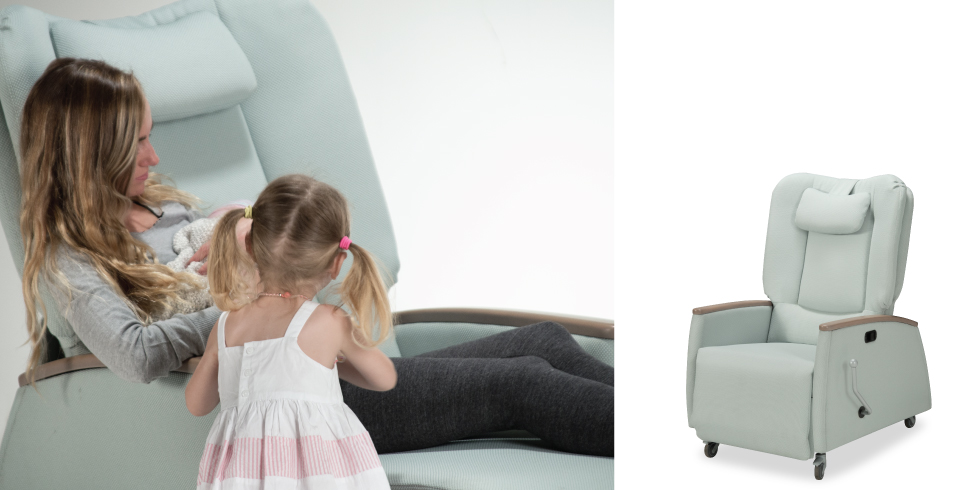
Kangaroo Care is a technique that was developed to encourage therapeutic touch between newborns and parents. The baby, wearing only a diaper, is placed in an upright position against a parent's bare chest, creating skin-to-skin contact. The parent then offers a snuggling effect by covering the back of the baby with a piece of cloth or the parent’s shirt, creating a look that resembles a kangaroo’s pouch. [1] Studies show that this close contact offers multiple benefits to the baby including deeper sleep, and more regular breathing and heart rates. [2] .
Touch therapies have influenced the design
The sense of touch develops in the womb and is believed to be the last sense to leave us. A large body of research developed over decades, has proven that the sense of touch provides many therapeutic benefits. However throughout history, Western medical professionals largely considered touch taboo, emphasizing healing machines over healing hands. Early neonatal intensive care units perhaps best exemplify this bias. Traditionally, babies born prematurely fought for their lives in incubators while parents watched helplessly nearby. Often separated by mere inches, mothers rarely penetrated the walls of the incubator to touch their babies. Units enforced “no-touch” and “minimal-touch” policies fearing that such stimulation would be harmful for the babies’ fragile states. [3]
By the 1980s, researchers began to investigate the impact of touch on infant weight gain and the significant results initiated major shifts in neonatal care. In one study, babies who received three 15-minute sessions of massage over the course of a week gained an amazing 47% more weight than the control group receiving standard medical care. [4] One of the researchers involved in the study, Tiffany Field, became personally invested in the research after the premature birth of her daughter.
Fueled by this life-changing experience and her firm belief in the healing power of touch, Field has since built an entire career exploring the many ways physical touch impacts health and wellbeing. Early in her career, Field connected with James Burke who shared her belief that touch was fundamental to our survival. Backed by a generous grant from Johnson & Johnson, Field established the world’s first institute devoted to the study of touch. Since 1992, the Touch Research Institute at the University of Miami School of Medicine has conducted over 100 studies on the benefits of touch therapies. Because of Field’s research and numerous other studies proving the therapeutic benefits of touch, neonatal intensive care unit caregivers now encourage hands-on participation from mothers and fathers, typically for several hours each day. [5]
Touch therapies have influenced the design of mother-baby units as well. Today, mothers typically labor, deliver, and recover all in the same room and their babies remain with them for most of this time. Gone are the days of nurses whisking newborns to the nursery so that mothers can recuperate in quiet. Research has shown that this early contact benefits both the baby and the mother. “Mothers with early contact are more satisfied with their infants and spend more time looking at and interacting with them. Early contact infants cry less and smile more than separated infants.”[6]
NICU parents still face many barriers that separate them from their premature infants, including the plastic walls of their baby's Isolette, a variety of caretakers, and the connection to high technology. IOA understood the importance of Kangaroo Care and recognized the need for patient experience improvement at the NICU unit in hospitals.
The IOA Kangaroo Chair was designed to utilize Kangaroo Care specifically in NICU settings.
The comfortable rocker-recliners can accompany each incubator and provide comfort, support and safety for both mother and newborn. The chair embraces the parent, allowing them to focus on the nurturing of their child, while also providing relaxation. The chair locks in all of its reclined positions, so there is no sudden movement that would be startling and potentially dangerous. Its wide back creates an absolute sense of safety and comfort while also offering support as mother and baby turn from side to side.
Though The Kangaroo Chair is considered a favorite chair for hospital departments dedicated to the care of women and children, not long after its introduction, The Kangaroo Chair found its way into other departments. Today, Oncology is the second most common application for The Kangaroo Chair after Labor & Delivery and NICU, as it provides the type of comfort and support needed by a patient undergoing a long and arduous treatment.
Whether a mother holding her newborn or a patient undergoing treatment, The Kangaroo Chair supports and nurtures in a way that no other chair can.
To purchase and learn more about The IOA Kangaroo Chair, please visit:
http://ioa-hcf.com/products/kangaroo
SOURCES:
1. The Cleveland Clinic Foundation. (2015, June 16) Kangaroo Care. Retrieved May 05, 2016, from https://my.clevelandclinic.org/childrens-hospital/health-info/ages-stages/baby/hic-Kangaroo-Care
2. Anderson, G.C. (1995). Touch and the kangaroo care method. In Field, T.M. (ed.), Touch in Early Development, 35-51.
3. Field, T.M. (2001). Touch, Cambridge: The MIT Press.
4. Field, T.M., Schanberg, S., Scafidi, F., Bower, C., Vega-Lahr, N., Garcia, R., Nystrom, J., and Kuhn, C. (1986). Tactile/kinesthetic stimulation effects on preterm neonates. Pediatrics 77 (5): 654-658.
5. The Cleveland Clinic Foundation. (2015, June 16) Kangaroo Care. Retrieved May 05, 2016, from https://my.clevelandclinic.org/childrens-hospital/health-info/ages-stages/baby/hic-Kangaroo-Care
6. Klaus, M., and Kennell, J. (1982). Parent-Infant Bonding, 2d ed., St. Louis: Mosby.
829 Blair Street
Thomasville, NC 27360
fax: 336-476-3016

